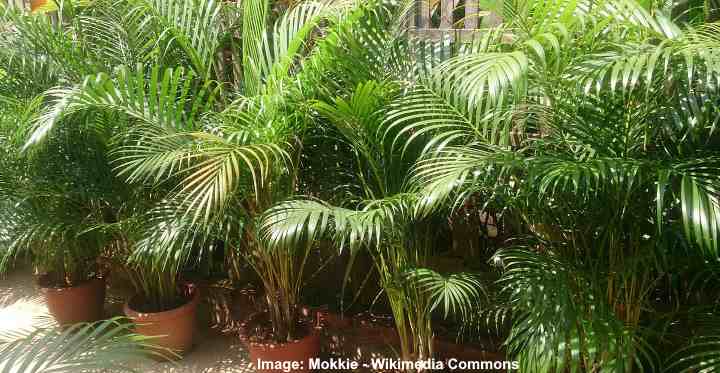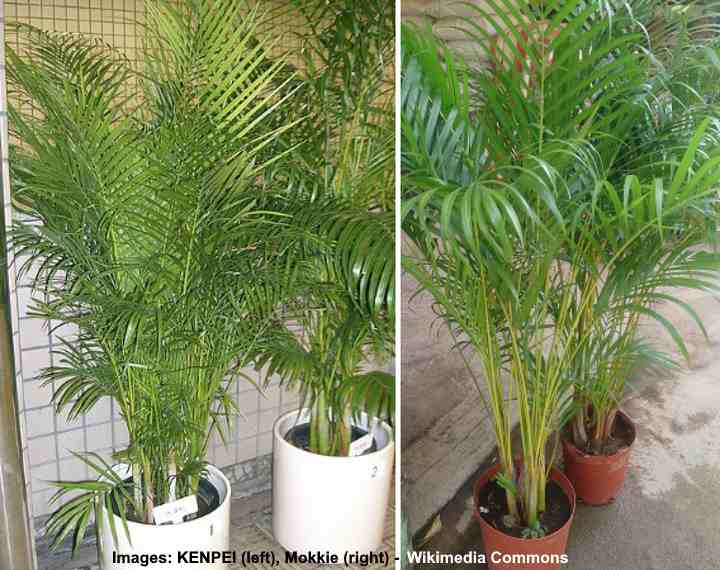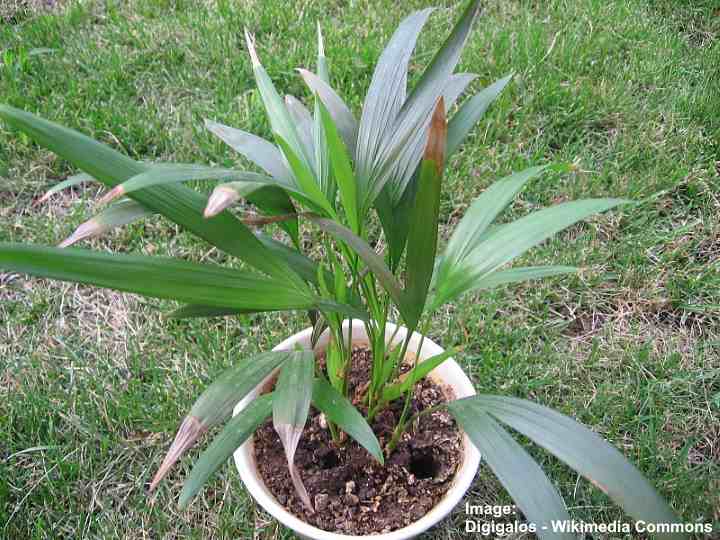Areca Palm Care: Complete Guide to Growing Areca Palm Tree Indoors

The areca palm (Dypsis lutescens) is an ornamental tropical palm with long, arching fronds and a bushy appearance. Also called the butterfly palm, golden cane palm, or yellow palm, this is a popular indoor palm tree. Areca palm is also known as Eureka palm but this name is incorrect as it’s a result of incorrect pronunciation of “Areca.”
Compared to other indoor palm plants, the areca palm is relatively easy to care for. Plenty of light and humidity will keep your areca palm looking healthy and prevent brown tips from appearing.
How to care for areca palm: Place your potted areca plant indoors in bright, indirect sunlight, only water it when the soil has partly dried, and feed occasionally. Areca palms need high humidity and temperatures between 65°F and 75°F (16°C – 24°C). Prune occasionally and don’t cut off brown tips from the leaves as it can cause the whole frond to die.
The clumping palm houseplant has a look similar to bamboo. Another name for this tropical plant is the bamboo palm due to the look of both the stems and leaves.
Areca palms have a growth rate of between 6” to 10” a year. Indoors they will grow to 6 ft. (1.8 m) high. With proper care, an indoor areca palm has a lifespan of around ten years.
In this article, you will learn how to care for an areca palm. You will also find out what to do about the most common problem with these palms—brown tips on the leaves.
Areca Palm Varieties
Areca palm (Dypsis lutescens, formerly Chrysalidocarpus lutescens) comes from Madagascar where it grows in the wild. The areca palm is one of the most popular houseplant palms because it is inexpensive and easy to grow. Similar varieties include the Triangle palm (Dypsis decaryi) and Betel Nut palm (Areca catechu).

Areca palms (Dypsis lutescens) are popular indoor palm plants in many houses
Areca Palm Brown Tips
Brown tips on an areca palm can be caused by too much or too little water, insufficient light, low humidity, too much fertilizer, or using chlorinated water. To prevent brown tips, only water when the soil has mostly dried out and keep in bright light away from direct sunlight.
Other problems common to growing areca palms indoors can also help identify the cause of brown tips. Some of these include:
- Yellowing leaves—Often caused by a lack of water or humidity.
- Yellow leaf spots—These are an indication of a nutrient buildup. Flush the soil or repot and use a balanced, water-soluble fertilizer every two months.
- Brown tips—As well as the problems already mentioned, brown palm leaf tips could be due to the plant being in a cold draft or a dry environment.
- Root rot—A common sign of over-watering with many houseplants, including palms. Hold off watering until the soil dries out. Repot if necessary to try and revive your plant.
How to Care for Areca Palm (Dypsis Lutescens)

Young areca palm
Although areca palms are easy to care for, they have a few essential needs to help them thrive. The four most crucial care requirements for areca palms are:
- Bright light—All palms need a lot of bright, filtered sunlight to thrive, and the areca palm is no exception.
- Humidity—Air moisture levels should be at least 40% to prevent brown tips and drooping leaves.
- Watering—Areca palms need moist soil that never becomes soggy or dries out completely. Water when the potting mix is partly dry.
- Fertilizer—Only feed the areca palm plant occasionally and flush the soil every so often.
So, that’s the basic requirements for looking after your golden cane plant properly. Let’s look in more detail at how to care for this indoor palm.
Light Requirements for Areca Palm (Golden Cane Palm)
Like most indoor palm trees, the areca palm craves bright light. The best location would be a west- or south-facing room where the palm gets plenty of light but also some direct sunlight. Only make sure that the sun doesn’t shine on it too much. A lot of direct sunlight results in scorched fronds.
The specific light requirements can make looking after indoor palms challenging. Apart from the parlor palm, palms are not low-light houseplants that like growing in the shade. So, put the plant pot in a location that’s not too dim and not excessively bright due to direct sunlight.
If you notice that the palm leaves turn yellowish-green, move it out of direct sunlight. If the palm leaves start to wilt and droop, make sure that it’s in a bright-enough location and has not dried out.
The common names for Dypsis lutescens – ‘yellow palm’ and ‘golden cane palm’ come from the yellow colors of the bamboo-like canes. If you care well for the areca palm, the palm leaves shouldn’t turn golden yellow.
Best Soil for Areca Palm (Butterfly Palm)
The right type of potting mix for an indoor areca palm is essential to its proper care. The perfect soil for palms should be well-draining soil that does not hold a lot of moisture. An ideal potting mix for palms would be a peat-based mix with perlite to create a lighter medium.
If the water is to drain well through the soil and not collect, there should be drainage holes in the pot. Peat is an ideal addition to the potting soil. The organic material holds enough moisture without becoming overly damp or soggy. The worst thing you can do to a butterfly palm is to have it sitting in waterlogged soil.
The right soil is also essential when talking about our next care tip—how to water an areca palm.
How to Water Areca Palm (Yellow Palm)
The time to water an areca palm growing indoors is when the soil is partly dry. Check to make sure that the top part of the potting mix is dry before watering. When it comes time to water, provide deep watering by pouring in enough water until it runs out of the pot’s drainage holes.
The next time to water your palm is when the soil has partly dried out again.
How often do you need to water a golden cane areca palm? The answer all depends on the level of moisture in the pot. Here are some practical watering tips to keep your areca palm healthy and prevent brown tips on the leaves:
- Frequency—Water more frequently in spring and summer than during fall and winter. Always test the soil for dryness before watering.
- Type of pot—Clay and terracotta pots allow moisture to evaporate quicker. So, you may need to water more often than palms growing in plastic containers.
- Water—Palms are sensitive to chemicals—fluoride and chlorine—so, leave water out for 24 hours before using. Letting water stand allows harmful chemicals to evaporate.
- Deep watering—Thorough, heavy watering ensures all the roots get nourished.
The Right Temperature for Areca Palm
Being a type of tropical palm tree, the areca palm thrives in average room temperatures. So, any temperature between 65°F and 75°F (16°C – 24°C) should be ideal. As a general rule, if you feel comfortable, your indoor palm will feel comfortable too.
Areca palms—just like many tropical houseplants—don’t like sudden changes in temperature. So, keep the palms away from cold drafts such as open windows and air conditioning vents. Protect your indoor palm trees from hot surfaces like radiators or furnaces.
Areca Palm (Dypsis lutescens) Humidity Needs
Getting humidity levels indoors is challenging when growing a golden cane palm indoors. High humidity is essential for healthy growth. Ways to increase room humidity for your palm include putting several houseplants together, daily misting, sitting on a pebble water tray, or using a humidifier.
Dry air is one of the reasons for brown tips appearing on areca palm leaves. What can you do to get humidity right and encourage healthy palm growth? Here are some helpful palm care tips:
- Daily misting—Fill a spray bottle with distilled water. Mist the palm leaves daily to help keep them moist.
- Pebble water tray—Put a layer of pebbles in a tray and fill with water until half-way up the stones. Place the plant pot on the pebbles. As water evaporates, it humidifies the leaves.
- Put houseplants together—Plants give off moisture as they respire (breathe). So, putting a few indoor plants together creates a humid environment.
- Humidifier—A room humidifier can help maintain ideal moisture levels for your house palms.
How to Feed Areca Palms
Butterfly palms need a moderate amount of fertilizer to prevent yellow leaves and promote growth. But too much feeding could lead to a buildup of mineral salts that can be damaging for your palm. Use a palm fertilizer or a houseplant fertilizer at half strength. Feed every two months during the growing season.
Too much fertilizer is yet another reason for brown tips on the leaves. Even if you feed your areca palm correctly, fertilizer can still build up in the pot. To prevent this from happening, flush the soil every few months.
To flush the soil, this is what you should do:
- Take the palm pot to the bath or shower.
- Let the water run through the potting mix for two or three minutes.
- Allow all the water to drain.
- Place your areca palm back in its bright location, away from direct sunlight.
- Feed your plant just after the next watering.
Getting the right balance of nutrients for your plant can be tricky. The golden cane palm likes magnesium, potassium, and iron. However, they can be sensitive to a buildup of fertilizer.
As a general rule, don’t feed your palm more often than every two months and avoid feeding during winter.
Areca Palm Propagation
Areca palms spread by growing from their base clusters of offshoots or canes. To propagate your areca palm, remove an offshoot with some of the roots from the base of the plant using a knife. Place the roots in a bowl of water for an hour and then transfer into a pot.
Another way to propagate an areca plant is from seeds. To grow an areca palm from seed, plant a few seeds in seed-starting soil in a pot. Place the container in a brightly-lit area, cover with plastic, and puncture some holes for ventilation. Keep the soil moist and the temperature above 80°F (26°C).
Usually, areca palm seeds are difficult to get from the plant. If you do get some, use the older, orange-colored seeds as they germinate better. Remember that areca palms are clumping plants, and you should plant several seeds in a pot. Planting several seeds together will result in a bushy, bamboo-like palm with elegant arching leaves.
Repotting Areca Palm (Dypsis lutescens)
One of the reasons why indoor areca palms are easy to care for is that they rarely need repotting. While some houseplants need repotting every year, you can repot a golden yellow palm every three years or less. Butterfly palms are planted in clumps and they form new clumps as they grow. Most palms thrive when they are slightly rootbound.
Repotting an areca palm every few years can help to refresh the soil and encourage better growth. Changing the potting mix also helps prevent fertilizer buildup.
Areca houseplant palms are quite sensitive when repotting. So, take care not to damage the roots. Many plant owners find that their palm leaves develop brown tips after repotting because they damaged too many of the roots.
To repot your butterfly palm, this is what you should do:
- Gently ease the palm and root ball out of the pot.
- Give the plant a gentle shake to remove any excess soil.
- Half-fill a new container with fresh, potting mix for palms.
- Place the palm in the new pot, making sure it’s at the same height as it was in the previous one.
- Top up with fresh potting soil and gently press around the stems to secure them.
Because a peat-based potting mix for palms already has plenty of nutrients, you don’t have to feed your plant for another two months after repotting.
Pruning Butterfly Palms
You can prune the fronds from an areca palm to help all the leaves get enough light. Generally, these palms are not sensitive to pruning, and occasionally cutting off some fronds can help a mature plant reach its 10-year lifespan.
It’s not advisable to prune the brown tips off palm leaves. Snipping off the brown tips can cause the whole frond to die. So, only trim dead fronds if they have turned brown or look unsightly.
Areca Palm Toxicity
Areca palms are not toxic to dogs, cats, other household pets, or humans.
Areca Palm Care: Diseases and Pests
An areca palm can seem to be dying if it’s affected by pests or diseases. The most common reason for palm diseases is over-watering. Common pests that can infest a golden cane palm include red spider mites, scale insects, mealybugs, and whiteflies.
Root rot is easily avoided by watering only when the soil is partly dry. Avoid sitting the plant pot in water where the soil becomes overly moist and soggy.
How can you spot pests on an areca palm? Here are a few tell-tale signs:
- Red spider mites—These pests thrive in dry conditions, so keeping humidity levels high is essential to prevent them. Signs of red spider mites are mottled yellow leaves and stunted growth.
- Scale insects—These palm pests look like tiny white bumps on the underside of leaves. You may notice brown spots on palm leaves or leaves that drop for no apparent reason.
- Mealybugs—Tiny bits of white fluff on your plant are signs of mealybugs. They will suck your plant dry and leave little black spots on the stems.
- Whitefly—These pests are easy to spot because the tiny white flies will fly off if you disturb the plant. Try placing yellow sticky tape near your palm to attract the flies and trap them.
To get rid of the pests that can infest your areca palm, you can hose the leaves with a strong jet of water. Do this twice a day until your pests are gone. Alternatively, you can try an organic neem oil solution to get rid of houseplant pests.
Common Problems Growing Areca Palm
What are some of the other issues you may have to deal with when growing an areca palm house plant indoors?
Brown spots on leaves
Researchers from Pennsylvania State University say that fluoride from tap water can cause brown, dead spots on leaves. If this happens, always water your plant with water that has been left out in bright light for 24 hours. The plant-damaging chemicals evaporate during this time and won’t poison your palm. (1)
Brown leaves and brown spots on leaves could also be a sign of over-fertilizing. Flush the soil and leave off feeding for at least six to eight weeks.
Yellow leaves
Yellow leaves on a palm is a classic sign of under-watering. To help revive a dying palm plant, give the soil deep watering to bring it back to life. Check the soil every few days after and water when the top part is dry, and the bottom half is still moist. Mist the leaves daily to help boost humidity levels.
Related articles:
